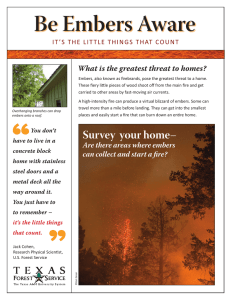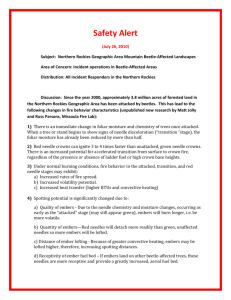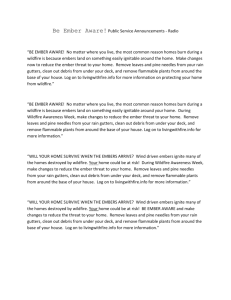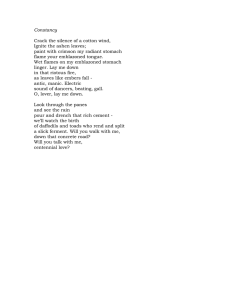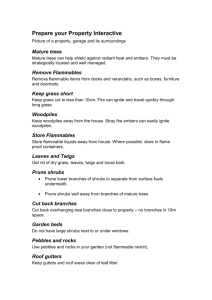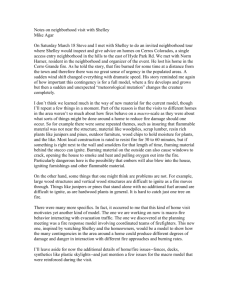I T ’S T H E ...
advertisement
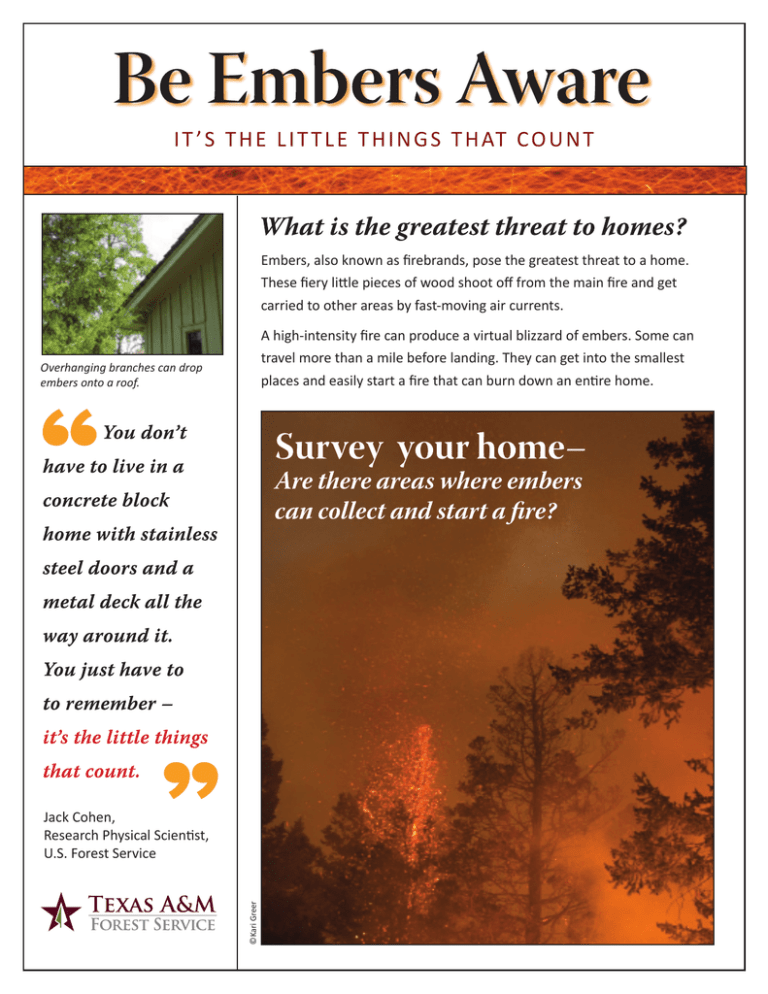
I T ’ S T H E L I T T L E T H I N G S T H AT C O U N T Embers, also known as firebrands, pose the greatest threat to a home. These fiery little pieces of wood shoot off from the main fire and get carried to other areas by fast-moving air currents. A high-intensity fire can produce a virtual blizzard of embers. Some can travel more than a mile before landing. They can get into the smallest places and easily start a fire that can burn down an entire home. Overhanging branches can drop embers onto a roof. ©Kari Greer Jack Cohen, Research Physical Scientist, U.S. Forest Service AROUND YOUR HOME Dormers, split-level roofs and lots of nooks and crannies create the perfect nest for burning embers. Pay particular attention to any and all inside corners. Wherever possible, cover those corners. Metal flashing is very effective. Check your gutters to ensure they are clear. Consider adding gutter guards or screening to prevent buildup of pine needles, leaves and other flammable debris. Debris can build up in corners, providing fuel for embers. Photo by Institute for Business and Home Safety Research Center. Vents provide the perfect opening for embers. Add a oneeighth-inch metal screen over the vent opening to create a barrier. Think about where leaves or trash accumulate when the wind blows. These are the areas where embers will collect and start a fire. Scout out openings like exterior crawl spaces or the critter zone under wooden porches and decks. Remove any flammable debris that you find underneath, such as leaves and pine needles. Then screen the open area using oneeighth-inch metal mesh to create a barrier for embers. Embers from flames can find their way into your attic through unscreened vents. Photo by Institute for Business and Home Safety Research Center. Inside corners can harbor embers. Visualize if there is anything that can burn easily. Look for the little things: Dry grass growing up against or leading to the foundation, dead vegetation underneath bushes and shrubs, a woodpile next to the home or on the deck, patio furniture cushions, etc. This photo shows damage to a wooden deck from embers. A R O U N D Y O U R YA R D A N D P R O P E R T Y Landscaping can serve as a fuel break by limiting flammable vegetation and materials surrounding the home where an ember could land and start a fire. Consider the entire “home ignition zone,” which extends up to 200 feet from the home. Your property does not have to be bare of vegetation to be Firewise. 30 feet adjacent to the home 30 to 100 feet from the home. Plants in this zone should be low-growing, well irrigated and less flammable. • Leave 30 feet between clusters of two to three trees, or 20 feet between individual trees. • Plants in this area should be limited to carefully (Diagram 4) spaced plantings that are low-growing and free of • Encourage a mixture of deciduous and resins, oils and waxes that burn easily. (Diagram 1) coniferous trees. Most deciduous trees do not • Mow the lawn regularly. Prune all trees so the lowest support high-intensity fires. limbs are at least 6 to 10 feet from the ground. • Give yourself added protection with “fuel • Space flammable conifer trees 30 feet between breaks,” such as driveways, gravel walkways and crowns to reduce the risk of crown fire. lawns. (Diagram 5) • Within 5 feet of the home, use nonflammable • Prune trees so branches and leaves are at least landscaping materials, such as rock, pavers and 6 to 10 feet above the ground. (Diagram 6) perennials with high-moisture content. (Diagram 2) • Remove dead vegetation, such as leaves and pine 100 to 200 feet from the home needles, from gutters, under your deck and within 10 This area should be thinned out as well, though feet of your home. less space is required than in Zone 2. • Firewood stacks and propane tanks should not be located in this area. Keep them at least 30 feet from • Remove heavy accumulation of woody debris. • Thin trees to remove smaller conifers. the home. (Diagram 3) • Water plants and trees regularly to ensure that they • Reduce the density of tall trees so canopies are not touching. (Diagram 7) are healthy and green, especially during fire season. This area should be well-irrigated and free from fuels that may ignite your home, such as dry vegetation, clutter and debris. 30 feet from home 200 feet from home 100 feet from home 7 4 3 1 2 6 5 I C A N M A KE M Y H O M E F I R E W I S E BY. . . Inspect your home where embers may land or hide. Remove the debris and make the area Firewise. Communities are safer when they work together. To learn more about becoming a Firewise Community, visit www.firewise.org. Embers destroyed this trampoline. Embers landing on this wood could set your deck on fire. Embers landed on this window. Gutters Dormers Vents Deck and porch Nooks and crannies Exterior crawl spaces Roof, especially split-level Patio furniture cushions Inside corners of home (porches and insets) Critter zones under wooden porch and deck Dry grass against or leading to foundation Dead vegetation underneath bushes and shrubs Wood pile next to home or deck Embers could ignite these needles. Embers damaged this roof. Learn more about protecting your home at property at www.texasfirewise.org To learn more, request one of these brochures. • Plan and Prepare: Is Your Home Ready? • Fire Resistant Landscaping • Fire Resistant Materials for Home Repair and Construction • Vegetation Management in the Wildland Urban Interface Some of the photos in this publication came from IBHS Research Center studies. Learn more at www.disastersafety.org. This institution is an equal opportunity provider. The work upon which this publication is based was funded in whole or in part through a grant awarded by the Southern Region, State and Private Forestry, U.S. Forest Service.
